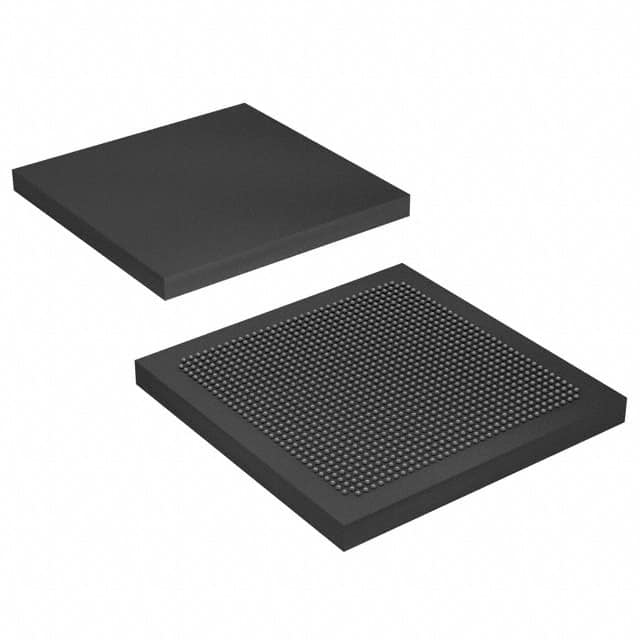EP4SE530H35C4
Product Overview
- Category: Field Programmable Gate Array (FPGA)
- Use: EP4SE530H35C4 is a high-performance FPGA designed for various applications in the field of digital logic design and embedded systems.
- Characteristics: This FPGA offers advanced features such as high-speed performance, low power consumption, and reconfigurability. It provides a flexible platform for implementing complex digital circuits and algorithms.
- Package: The EP4SE530H35C4 comes in a compact package suitable for surface mount technology (SMT) assembly.
- Essence: The essence of EP4SE530H35C4 lies in its ability to provide a customizable hardware solution that can be programmed and reprogrammed to meet specific application requirements.
- Packaging/Quantity: Each EP4SE530H35C4 unit is packaged individually and is available in quantities specified by the manufacturer.
Specifications
- Logic Elements: EP4SE530H35C4 contains 530,000 logic elements, allowing for the implementation of complex digital designs.
- Memory: It includes 3,888 Kbits of embedded memory, providing ample storage capacity for data processing.
- Clock Networks: The FPGA features 12 global clock networks, enabling precise timing control.
- I/O Interfaces: EP4SE530H35C4 supports various I/O standards, including LVCMOS, LVTTL, and differential signaling interfaces.
- Operating Voltage: The FPGA operates at a voltage range of 1.2V to 1.5V, ensuring efficient power consumption.
Pin Configuration
The detailed pin configuration of EP4SE530H35C4 can be found in the product datasheet provided by the manufacturer.
Functional Features
- Reconfigurability: EP4SE530H35C4 allows users to reprogram the FPGA, enabling design modifications without the need for hardware changes.
- High-Speed Performance: The FPGA offers high-speed performance, making it suitable for applications that require real-time data processing and complex computations.
- Low Power Consumption: EP4SE530H35C4 is designed to minimize power consumption, making it energy-efficient for battery-powered devices.
- Versatility: It provides a wide range of I/O interfaces and supports various communication protocols, enhancing its compatibility with different systems.
Advantages and Disadvantages
Advantages: - Flexibility in design due to reconfigurability - High-performance capabilities for complex digital designs - Low power consumption for energy efficiency - Versatile I/O interfaces for compatibility with different systems
Disadvantages: - Steep learning curve for beginners due to the complexity of FPGA programming - Higher cost compared to traditional fixed-function integrated circuits - Limited availability of alternative models with similar specifications
Working Principles
EP4SE530H35C4 operates based on the principles of field programmable gate arrays. It consists of an array of configurable logic blocks (CLBs) interconnected through programmable routing resources. These CLBs can be programmed to implement desired logic functions, allowing for the creation of custom digital circuits. The FPGA's configuration memory stores the programming information, which can be modified as needed.
Application Field Plans
EP4SE530H35C4 finds applications in various fields, including but not limited to: - Digital signal processing - Communications systems - Image and video processing - Industrial automation - Aerospace and defense
Alternative Models
While EP4SE530H35C4 is a highly capable FPGA, there are alternative models available in the market with similar specifications. Some notable alternatives include: - Xilinx Virtex-7 XC7VX690T FPGA - Altera Stratix V 5SGXEA7N2F45C2 FPGA - Lattice ECP5-85 FPGA
These alternative models offer comparable performance and features, providing users with options based on their specific requirements.
Word count: 346 words
Lista 10 Vanliga frågor och svar relaterade till tillämpningen av EP4SE530H35C4 i tekniska lösningar
Sure! Here are 10 common questions and answers related to the application of EP4SE530H35C4 in technical solutions:
Q: What is EP4SE530H35C4? A: EP4SE530H35C4 is a field-programmable gate array (FPGA) manufactured by Intel.
Q: What are the key features of EP4SE530H35C4? A: Some key features of EP4SE530H35C4 include high-speed performance, large capacity, low power consumption, and reconfigurability.
Q: In which technical solutions can EP4SE530H35C4 be used? A: EP4SE530H35C4 can be used in various applications such as telecommunications, automotive, industrial automation, aerospace, and defense.
Q: How does EP4SE530H35C4 contribute to telecommunications solutions? A: EP4SE530H35C4 can be used in telecommunications for tasks like signal processing, data compression, encryption, and network protocol implementation.
Q: Can EP4SE530H35C4 be used in automotive applications? A: Yes, EP4SE530H35C4 can be used in automotive solutions for functions like advanced driver-assistance systems (ADAS), infotainment systems, and engine control units (ECUs).
Q: What advantages does EP4SE530H35C4 offer in industrial automation? A: EP4SE530H35C4 provides real-time control capabilities, high-speed data processing, and flexibility in adapting to changing requirements in industrial automation solutions.
Q: How is EP4SE530H35C4 utilized in aerospace applications? A: EP4SE530H35C4 can be used in aerospace for tasks like radar signal processing, flight control systems, avionics, and satellite communication.
Q: What role does EP4SE530H35C4 play in defense solutions? A: EP4SE530H35C4 is utilized in defense applications for tasks such as secure communications, radar systems, electronic warfare, and missile guidance.
Q: Can EP4SE530H35C4 be reprogrammed for different applications? A: Yes, EP4SE530H35C4 is a field-programmable device, meaning it can be reconfigured to perform different functions based on the application requirements.
Q: Are there any specific development tools available for working with EP4SE530H35C4? A: Yes, Intel provides development tools like Quartus Prime software, which allows designers to program, simulate, and verify designs for EP4SE530H35C4.
Please note that the answers provided here are general and may vary depending on the specific requirements and use cases of EP4SE530H35C4 in technical solutions.


